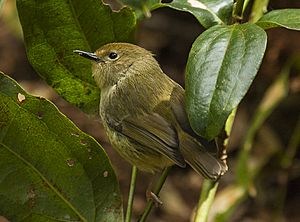Large-billed scrubwren facts for kids
Quick facts for kids Large-billed scrubwren |
|
|---|---|
 |
|
| at Lamington National Park, Queensland. | |
| Conservation status | |
| Scientific classification | |
| Genus: |
Sericornis
|
| Species: |
magnirostra
|
| Subspecies | |
|
|
| Synonyms | |
|
Sericornis magnirostris |
|
The large-billed scrubwren (Sericornis magnirostra) is a small songbird that lives only in eastern Australia. It belongs to a bird family called Acanthizidae. You can find this bird in thick bushes and trees in different types of forests, like cool forests and warm, wet forests on lowlands or mountains.
Contents
Understanding the Large-billed Scrubwren's Name
The large-billed scrubwren was first described by a bird expert named John Gould in 1838.
Its scientific name, Sericornis magnirostra, tells us a bit about the bird. The first part, Sericornis, comes from Ancient Greek words meaning 'silk' and 'bird'. This might refer to its soft feathers. The second part, magnirostra, comes from Latin words meaning 'great' and 'bill'. This describes its noticeably large bill.
This bird is part of the Acanthizidae family. This family includes many small, insect-eating birds found in Australia and New Zealand.
There are three different types, or subspecies, of the large-billed scrubwren. They are Sericornis magnirostra magnirostra, S. m. viridior, and S. m. howei.
What Does the Large-billed Scrubwren Look Like?
The large-billed scrubwren is a small bird, usually about 11.5 to 13 cm (4.5 to 5.1 in) long. It weighs around 10 g (0.35 oz), which is about the same as a few paperclips.
It has dark reddish-brown eyes and a light, pale face. Its bill is black, quite long, and points slightly upwards. The top part of its body is a light grey-brown with a hint of olive green. Its throat is a pale white, and its belly is greyish. The rump and tail feathers are a light reddish-brown color.
Where the Large-billed Scrubwren Lives
You can find the large-billed scrubwren along the eastern coast of Australia. Its range stretches from near Cooktown in northern Queensland all the way down to Kinglake and the Dandenong Ranges near Melbourne, Victoria.
The three subspecies live in different areas within this range:
- Sericornis magnirostra magnirostra lives from the Clarke Range in Queensland down to East Gippsland in Victoria.
- S. m. viridior is found in northeast Queensland, from Mt Amos to the Paluma Range National Park.
- S. m. howei lives in West Gippsland and the Strzelecki Ranges in southern Victoria.
This bird prefers to live in rainforests in warmer, tropical areas. In cooler, temperate regions, it likes wet sclerophyll forests, which have tough-leaved trees like eucalyptus. It tends to stay in one place and is more common in the northern parts of its habitat.
Large-billed Scrubwren Behavior
Reproduction and Life Cycle
Large-billed scrubwrens usually breed from July to January, with most activity in November and December. They build a rough, dome-shaped nest. This nest is made from bark, grass, and moss. Inside, it's lined with soft feathers to keep the young warm. They often place their nests in climbing plants, tree-ferns, or palm leaves.
Sometimes, they even use nests that other birds, like the yellow-throated scrubwren, have left behind. A female scrubwren will lay 3 or 4 eggs. Each egg is about 19 mm × 15 mm (0.7 in × 0.6 in) in size. The eggs are a dull white or light purplish-brown, often with small spots at the wider end. We don't know how long the eggs take to hatch. Once they hatch, the young birds stay in the nest for about 13 days.
Sometimes, other birds called cuckoos lay their eggs in the scrubwren's nest. These include the fan-tailed cuckoo and the chestnut-breasted cuckoo. The cuckoo chicks will then be raised by the scrubwren parents.
How the Large-billed Scrubwren Finds Food
The large-billed scrubwren looks for food in the lower and middle parts of the forest. They often forage in small groups. These birds are insectivorous, meaning they eat insects. They search for different arthropods, like spiders, ants, wasps, and beetles. They also eat caterpillars. They find their food by picking it off tree trunks and branches. They also search among leaves and other bits of nature hanging in vines and on plants growing on trees.
Vocalization and Calls
The large-billed scrubwren is usually a quiet bird. However, it does make some distinct calls. When marking its territory, it might make a strong, clear "s-cheer s-cheer" sound. While feeding, it can make a sharp, loud "chwip-chwip" or a chattering "sip-sip" sound.
Conservation Status
The large-billed scrubwren is doing well in the wild. It has a wide area where it lives, and its population seems to be stable. Because of this, it is listed as a species of least concern on the IUCN Red List. This means it is not currently considered to be at risk of extinction.
See also
 In Spanish: Sedosito picudo para niños
In Spanish: Sedosito picudo para niños


